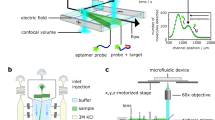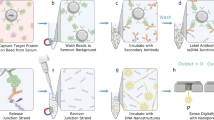Abstract
The quantitative immuno-PCR (qIPCR) technology combines the advantages of flexible and robust immunoassays with the exponential signal amplification power of PCR. The qIPCR allows one to detect antigens using specific antibodies labeled with double-stranded DNA. The label is used for signal generation by quantitative PCR. Because of the efficiency of nucleic acid amplification, qIPCR typically leads to a 10- to 1,000-fold increase in sensitivity compared to an analogous enzyme-amplified immunoassay. A standard protocol of a qIPCR assay to detect human interleukin 6 (IL-6) using a sandwich immunoassay combined with real-time PCR readout is described here. The protocol includes initial immobilization of the antigen, and coupling of this antigen with antibody–DNA conjugates is then carried out by (a) the stepwise assembly of biotinylated antibody, streptavidin and biotinylated DNA, (b) the use of a biotinylated antibody and an anti-biotin–DNA conjugate or (c) the employment of an anti-IL-6 antibody–DNA conjugate. Following the assembly of signal-generating immunocomplexes, real-time PCR is used to amplify and record the signal. Depending on the coupling strategy, the qIPCR assays require 4–7 h with only about 3 h hands-on-time. The use of qIPCR assays enables the detection of rare biomarkers in complex biological samples that are poorly accessible by conventional immunoassays. Therefore, qIPCR offers novel opportunities for the biomedical analysis of, for instance, neurodegenerative diseases and viral infections as well as new tools for the development of novel pharmaceuticals.
This is a preview of subscription content, access via your institution
Access options
Subscribe to this journal
Receive 12 print issues and online access
$259.00 per year
only $21.58 per issue
Buy this article
- Purchase on Springer Link
- Instant access to full article PDF
Prices may be subject to local taxes which are calculated during checkout




Similar content being viewed by others
References
Mullis, K.B. & Faloona, F. Specific synthesis of DNA in vitro via a polymerase-catalyzed chain reaction. Methods Enzymol. 155, 335–350 (1987).
Saiki, R.K. et al. Primer-directed enzymatic amplification of DNA with a thermostable DNA polymerase. Science 239, 487–491 (1988).
Sano, T., Smith, C.L. & Cantor, C.R. Immuno-PCR: very sensitive antigen detection by means of specific antibody–DNA conjugates. Science 258, 120–122 (1992).
Niemeyer, C.M., Adler, M. & Wacker, R. Immuno-PCR: high sensitivity detection of proteins by nucleic acid amplification. Trends Biotechnol. 23, 208–216 (2005).
Zhou, H., Fisher, R.J. & Papas, T.S. Universal immuno-PCR for ultra-sensitive target protein detection. Nucleic Acids Res. 21, 6038–6039 (1993).
Lind, K. & Kubista, M. Development and evaluation of three real-time immuno-PCR assemblages for quantification of PSA. J. Immunol. Methods 304, 107–116 (2005).
Hendrickson, E.R., Hatfield Truby, T.M., Joerger, R.D., Majarian, W.R. & Ebersole, R.C. High sensitivity multianalyte immunoassay using covalent DNA-labeled antibodies and polymerase chain reaction. Nucleic Acids Res. 23, 522–529 (1995).
Niemeyer, C.M. et al. Self-assembly of DNA-streptavidin nanostructures and their use as reagents in immuno-PCR. Nucleic Acids Res. 27, 4553–4561 (1999).
Joerger, R.D., Truby, T.M., Hendrickson, E.R., Young, R.M. & Ebersole, R.C. Analyte detection with DNA-labeled antibodies and polymerase chain reaction. Clin. Chem. 41, 1371–1377 (1995).
Heid, C.A., Stevens, J., Livak, K.J. & Williams, P.M. Real time quantitative PCR. Genome Res. 6, 986–994 (1996).
Kubista, M. et al. The real-time polymerase chain reaction. Mol. Aspects Med. 27, 95–125 (2006).
Adler, M., Wacker, R. & Niemeyer, C.M. A real-time immuno-PCR assay for routine ultrasensitive quantification of proteins. Biochem. Biophys. Res. Commun. 308, 240–250 (2003).
Sims, P.W., Vasser, M., Wong, W.L., Williams, P.M. & Meng, Y.G. Immunopolymerase chain reaction using real-time polymerase chain reaction for detection. Anal. Biochem. 281, 230–232 (2000).
Niemeyer, C.M., Adler, M. & Blohm, D. Fluorometric polymerase chain reaction (PCR) enzyme-linked immunosorbent assay for quantification of immuno-PCR products in microplates. Anal. Biochem. 246, 140–145 (1997).
Maia, M., Takahashi, H., Adler, K., Garlick, R.K. & Wands, J.R. Development of a two-site immuno-PCR assay for hepatitis B surface antigen. J. Virol. Methods 52, 273–286 (1995).
Zhang, Z., Irie, R.F., Chi, D.D. & Hoon, D.S. Cellular immuno-PCR. Detection of a carbohydrate tumor marker. Am. J. Pathol. 152, 1427–1432 (1998).
Saito, K. et al. Detection of human serum tumor necrosis factor-alpha in healthy donors, using a highly sensitive immuno-PCR assay. Clin. Chem. 45, 665–669 (1999).
Ren, J. et al. Detection of circulating CEA molecules in human sera and leukopheresis of peripheral blood stem cells with E. coli expressed bispecific CEAScFv-streptavidin fusion protein-based immuno-PCR technique. Ann. NY Acad. Sci. 945, 116–118 (2001).
Ren, J. et al. Detection of circulating gastric carcinoma-associated antigen MG7-Ag in human sera using an established single determinant immuno-polymerase chain reaction technique. Cancer 88, 280–285 (2000).
Adler, M., Schulz, S., Fischer, R. & Niemeyer, C.M. Detection of Rotavirus from stool samples using a standardized immuno-PCR ('Imperacer') method with end-point and real-time detection. Biochem. Biophys. Res. Commun. 333, 1289–1294 (2005).
Barletta, J.M., Edelman, D.C. & Constantine, N.T. Lowering the detection limits of HIV-1 viral load using real-time immuno-PCR for HIV-1 p24 antigen. Am. J. Clin. Pathol. 122, 20–27 (2004).
Adler, M. et al. Adaptation and performance of an immuno-PCR assay for the quantification of Aviscumine in patient plasma samples. J. Pharm. Biomed. Anal. 39, 972–972 (2005).
Schoffski, P. et al. Phase I trial of intravenous aviscumine (rViscumin) in patients with solid tumors: a study of the European Organization for Research and Treatment of Cancer New Drug Development Group. Ann. Oncol. 15, 1816–1824 (2004).
McElhinny, A.S., Kadow, N. & Warner, C.M. The expression pattern of the Qa-2 antigen in mouse preimplantation embryos and its correlation with the Ped gene phenotype. Mol. Hum. Reprod. 4, 966–971 (1998).
Barletta, J.M., Edelman, D.C., Highsmith, W.E. & Constantine, N.T. Detection of ultra-low levels of pathologic prion protein in scrapie infected hamster brain homogenates using real-time immuno-PCR. J. Virol. Methods 127, 154–164 (2005).
Chye, S.M., Lin, S.R., Chen, Y.L., Chung, L.Y. & Yen, C.M. Immuno-PCR for detection of antigen to Angiostrongylus cantonensis circulating fifth-stage worms. Clin. Chem. 50, 51–57 (2004).
Adler, M. et al. Detection of rViscumin in plasma samples by immuno-PCR. Biochem. Biophys. Res. Commun. 300, 757–763 (2003).
Case, M.C. et al. Enhanced ultrasensitive detection of structurally diverse antigens using a single immuno-PCR assay protocol. J. Immunol. Methods 223, 93–106 (1999).
Sugawara, K. et al. A highly sensitive immuno-polymerase chain reaction assay for human angiotensinogen using the identical first and second polyclonal antibodies. Clin. Chim. Acta. 299, 45–54 (2000).
Adler, M., Wacker, R., Booltink, E., Manz, B. & Niemeyer, C.M. Detection of femtogram amounts of biogenic amines using self-assembled DNA–protein nanostructures. Nat. Methods 2, 147–149 (2005).
Niemeyer, C.M., Wacker, R. & Adler, M. Hapten-functionalized DNA-streptavidin nanocircles as supramolecular reagents in a novel competitive immuno-PCR. Angew. Chem. Int. Ed. 40, 3169–3172 (2001).
Adler, M. Immuno-PCR as a clinical laboratory tool. Adv. Clin. Chem. 39, 239–292 (2005).
Kakizaki, E. et al. Detection of bacterial antigens using immuno-PCR. Lett. Appl. Microbiol. 23, 101–103 (1996).
Author information
Authors and Affiliations
Contributions
M.A. carried out the immunoassays, analyzed the data and wrote the manuscript; R.W. analyzed the data, prepared figures and wrote the manuscript; and C.M.N. designed and coordinated the research, analyzed the data and wrote the manuscript.
Corresponding authors
Ethics declarations
Competing interests
Adler and Wacker declare employment at Chimua Biotec. Niemeyer declares financial interest as a co-founder and share holder of Chimua Biotec.
Rights and permissions
About this article
Cite this article
Niemeyer, C., Adler, M. & Wacker, R. Detecting antigens by quantitative immuno-PCR. Nat Protoc 2, 1918–1930 (2007). https://doi.org/10.1038/nprot.2007.267
Published:
Issue Date:
DOI: https://doi.org/10.1038/nprot.2007.267
This article is cited by
-
A one-pot isothermal Cas12-based assay for the sensitive detection of microRNAs
Nature Biomedical Engineering (2023)
-
Ultra-sensitive AAV capsid detection by immunocapture-based qPCR following factor VIII gene transfer
Gene Therapy (2022)
-
Development of an ultra-sensitive human IL-33 biomarker assay for age-related macular degeneration and asthma drug development
Journal of Translational Medicine (2021)
-
An Overview on SARS-CoV-2 (COVID-19) and Other Human Coronaviruses and Their Detection Capability via Amplification Assay, Chemical Sensing, Biosensing, Immunosensing, and Clinical Assays
Nano-Micro Letters (2021)
-
DNA structures embedded with functionalized nanomaterials for biophysical applications
Journal of the Korean Physical Society (2021)
Comments
By submitting a comment you agree to abide by our Terms and Community Guidelines. If you find something abusive or that does not comply with our terms or guidelines please flag it as inappropriate.



